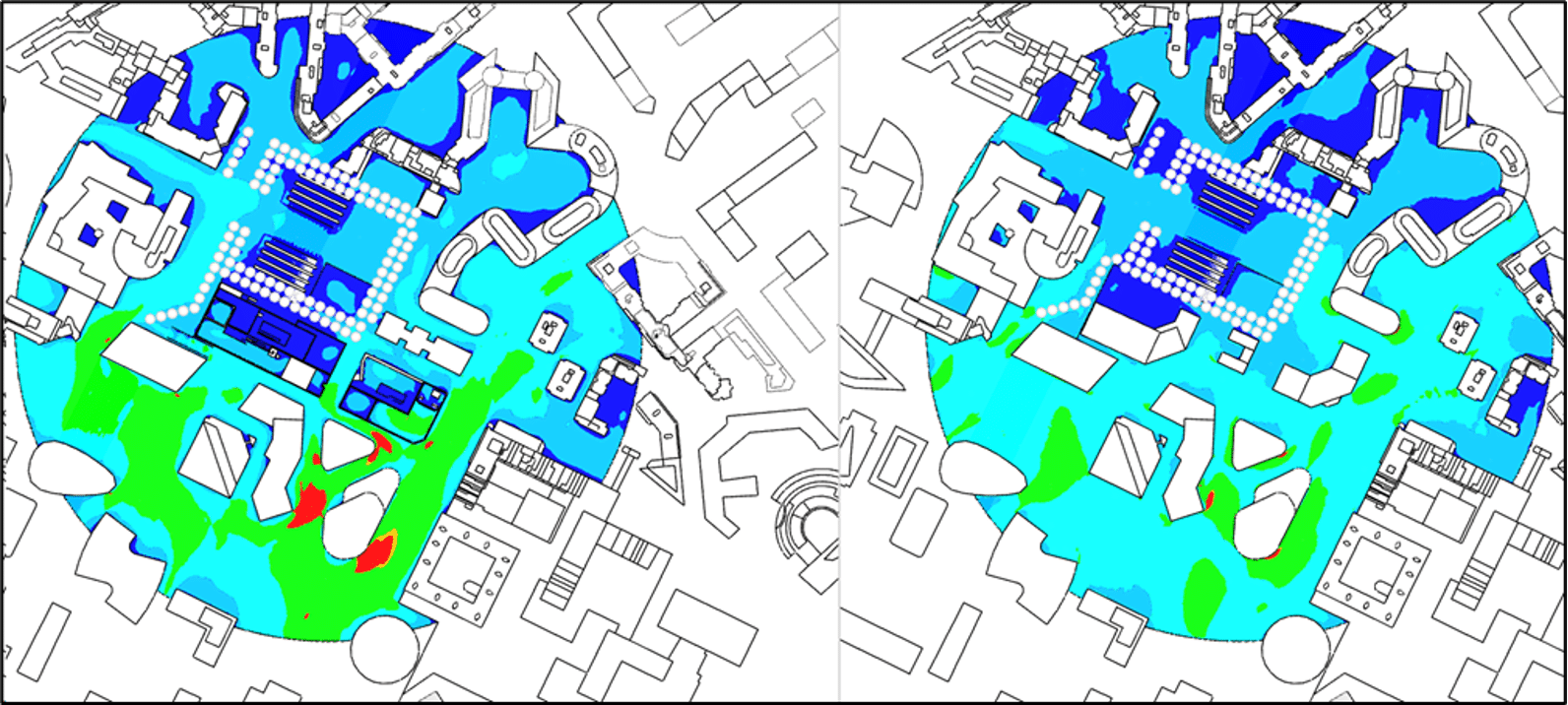Pedestrian comfort criteria and mapping
Home » Air & Wind » Pedestrian comfort criteria and mapping
EOLIOS, engineers of urban comfort
The quality of urban life often lies in the small details that shape our daily lives. Among these, pedestrian comfort plays a fundamental role. It’s an essential component of urban mobility, influencing not only residents’ walking experience, but also their safety, well-being and desire to make walking a priority.
On this page, we look at the criteria that determine pedestrian comfort, as well as the mapping tools that can be used to assess and improve this crucial aspect of urban spaces. We’ll explore comprehensive resources and case studies that illustrate how a methodical, scientific approach can transform our urban designs into pedestrian-friendly places.
By combining sophisticated analysis with proven practices, Eolios is committed to redefining the standards of pedestrian comfort to encourage more accessible, safer and livable cities for all. Enter the world of pedestrian comfort and discover how good urban design practices can make a difference for millions of users of public spaces.
Our projects :
How do you calculate pedestrian comfort?
Influence of wind on pedestrian comfort
Heavily urbanized areas, such as the La Défense district, create regions where winds reach higher speeds, due to the height of the buildings and their high concentration. TheVenturi effect is responsible for these areas of high wind speeds: the cross-section of the wind is reduced by the presence of buildings, so the wind is accelerated.
High wind speeds can pose problems for the comfort and safety of building users (using terraces or balconies), but also for pedestrians (or even cyclists) moving through these densely built-up areas. It is therefore legitimate to ask what is the criterion at which wind speed becomes uncomfortable, or even dangerous.
Wind comfort study for La Défense
Assessing wind comfort levels
Heavily urbanized areas, such as the La Défense district, create regions where winds reach higher speeds, due to the height of the buildings and their high concentration. TheVenturi effect is responsible for these areas of high wind speeds: the cross-section of the wind is reduced by the presence of buildings, so the wind is accelerated. High wind speeds can pose problems for the comfort and safety of building users (using terraces or balconies), but also for pedestrians (or even cyclists) moving through these densely built-up areas. It is therefore legitimate to ask what is the criterion at which wind speed becomes uncomfortable, or even dangerous.

This scale classifies wind force according to speed and the feelings of people potentially exposed to these wind speeds. Force is characterized by a scale ranging from 0 to 12, the Beaufort scale. We don’t present the scale beyond force 9, as it then concerns the most extreme cases (from storms to hurricanes), and most of the scales we’ll present below consider wind to be dangerous from force 8 upwards.
All the criteria presented below have the initial aim of ensuring that new urban developments are designed to minimize the negative impacts of wind on the comfort and safety of residents and users. In this way, they guarantee a better quality of life for city dwellers.
Wind comfort criteria
London LDDC criteria
The London criterion, attributed to the London Docklands Development Corporation (LDDC), first appeared in the 1980s. At the time, the rapid development of urban areas, particularly in London, raised growing concerns about living conditions in these densely populated environments. The London criterion was designed to provide standards for urban planning, with particular emphasis on managing the effects of wind. It sets a threshold speed for different areas of activity, as shown in the table below. Not every activity has the same comfort threshold.
For example, a person sitting outside on a bench or terrace is more likely to feel uncomfortable when the wind speed increases than someone on the move (walking, running or even cycling).
For very high speeds, the criterion informs us that the wind becomes uncomfortable or dangerous for any type of activity.
All the criteria we present in this article can be read in the same way. Here we describe the London criterion in detail:
- Long Seat: speeds exceed 2.5 m/s less than 5% of the time
- Short seat: wind speed exceeds 4 m/s less than 5% of the time
- Walking at a leisurely pace: speeds in excess of 6 m/s are observed less than 5% of the time
- Walking fast: speeds in excess of 8 m/s are felt less than 5% of the time
- Uncomfortable: a wind speed of 8 m/s is exceeded 5% or more of the time
- Finally, a region is considered hazardous when wind speeds reach 15 m/s with a frequency of at least 0.022%.
For each criterion presented, we show the maps associated with the Courbevoie school project. The map on the left always refers to the project, and the map on the right refers to the baseline (pre-project) or existing state.
Lawson's criteria
The Lawson criterion was first proposed by T.V. Lawson in his 1978 article “The wind content of the built environment” [1]. Like the previous criterion, Lawson’s criterion is based on a threshold according to the activity performed by the user. There are several of these, which we describe below.
Lawson LDDC criterion
The Lawson LDDC criterion indicates a state of comfort in the wind for different activities.
Of the three Lawson criteria presented in this article, this is the most widely used.
- Outdoor dining: speeds exceeding 2 m/s less than 5% of the time
- Seated pedestrian : wind speed exceeds 4 m/s less than 5% of the time
- Standing pedestrian : speeds greater than 6 m/s are observed less than 5% of the time
- Walking pedestrian: speeds in excess of 8 m/s are felt less than 5% of the time
- Fast running: a wind speed of 10 m/s is exceeded less than 5% of the time
- The area is considered uncomfortable when wind speeds exceed 10 m/s more than 5% of the time.
Lawson LDDC criterion
Lawson’s criterion gives other thresholds for the comfort of outdoor activities.
It is close to the London LDDC criterion presented above, but with different threshold speed values.
- Long Seat: speeds exceeding 1.8 m/s less than 2% of the time.
- Short seat: wind speed exceeds 3.6 m/s less than 2% of the time.
- Walk quietly : speeds in excess of 5.3 m/s are observed less than 2% of the time.
- Walking fast: speeds in excess of 7.6 m/s are felt less than 2% of the time.
- Uncomfortable: a wind speed of 7.6 m/s is exceeded 2% or more of the time.
Lawson LDDC criterion
This last Lawson criterion also includes the hazardous nature of certain wind speed values, completing the comfort thresholds.
- Sitting: speeds exceeding 4 m/s less than 5% of the time.
- Standing: wind speed exceeds 6 m/s less than 5% of the time.
- Walking: speeds in excess of 8 m/s are observed less than 5% of the time.
- Walking fast : speeds in excess of 10 m/s are felt less than 5% of the time.
- Uncomfortable 10 m/s wind speed is exceeded 5% or more of the time.
- Unsafe: wind speeds in excess of 15 m/s are reached 0.023% of the time or more.
- Dangerous: a wind speed greater than 20 m/s is reached 0.023% of the time or more.
Cartography
For each criterion presented, we show the maps associated with the Courbevoie school project for two of Lawson’s criteria (Lawson LDDC and Lawson).
Davenport criteria
This criterion was established by Professor A.G. Davenport in the 1970s to investigate the effect wind can have on the world’s tallest buildings. In particular, he worked on various parts of Manhattan in New York City (which is known as a very dense urban area), including the World Trade Center district.
He sets out his criteria in various articles, including “An approach to human comfort criteria for environmental wind conditions” [2] and “Approaches to the design of tall buildings against wind” [3]. The Davenport criterion , like the two preceding ones, sets a tolerable wind speed threshold for each activity. It is presented in the table below.
The Davenport criterion gives further thresholds for the comfort of outdoor activities.
It is close to the Lawson (simple) criterion presented above, but with different threshold speed values and safety criteria, bringing it closer to the London LDDC criterion.
- Long Seat: speeds exceeding 3.6 m/s less than 1.5% of the time.
- Short seat: wind speed exceeds 5.3m/s less than 1.5% of the time.
- Walk quietly: speeds in excess of 7.6 m/s are observed less than 1.5% of the time.
- Walking fast: speeds in excess of 9.8 m/s are felt less than 1.5% of the time.
- Uncomfortable: a wind speed of 9.8 m/s is exceeded 1.5% of the time or more.
- The danger threshold is set for wind speeds exceeding 15.1 m/s at least 0.01% of the time.
For this criterion, we also display the associated maps of the La Défense district, where the middle school andEuropean school project are located.
NEN 8100 criteria
The NEN 8100 criterion was first proposed in 2005 by the Netherlands Institute for Standardization(NEN in Dutch) and is presented in the article “Wind comfort and wind danger in the built environment” [4]. It sets a threshold wind speed of 5m/s for all activities, and is based on the probability of exceeding or not exceeding this speed. This same wind comfort criterion is derived from another, based on the wind hazard threshold speed, set at 15m/s. These two criteria are presented in two different sections below.
NEN 8100 criteria for comfort
This criterion sets acceptable comfort thresholds for different types ofoutdoor activity. It is presented in the table below and detailed below.
The NEN 8100 criterion is similar to Lawson’s (simple) criterion, but with the distinctive feature of a threshold speed identical for all activities: in fact, what varies is the probability threshold for exceeding these speeds, as we shall see.
- Long Seat : speeds in excess of 5 m/s less than 2.5% of the time.
- Assise Courte : wind speed exceeds 5m/s less than 5% of the time.
- Walk quietly: speeds in excess of 5 m/s are observed less than 10% of the time.
- Walking fast: speeds in excess of 5 m/s are felt less than 20% of the time.
- Uncomfortable: a wind speed of 5 m/s is exceeded 20% of the time or more.
NEN 8100 criteria for safety
This criterion sets hazard thresholds for all outdoor activities. It is presented in the table below and detailed below.
Unlike the other criteria presented in this article, This criterion focuses solely on the safety of pedestrians in a given area. It is divided into 3 different categories:
- No risk : if speeds exceed 15 m/s less than 0.05% of the time.
- Limited risk : if speeds exceed 15m/s less than 0.3% of the time.
- Dangerous : if speeds exceed 15m/s more than 0.3% of the time.
Cartography
We present two maps using these two criteria below for the Courbevoie school district. Whatever the standard used, we can see that comfort levels in the area are virtually identical for the existing and the project.
Which criteria to choose?
Wind comfort and safety criteria vary according to pedestrian activity and the standards used. It’s important to choose the appropriate criterion according to the study to be carried out, as some standards may focus solely on the comfort aspect, or solely on the safety aspect (and sometimes even both). For example, the NEN 8100 standard focuses either solely on comfort or solely on safety, while other standards may take both comfort and safety into account (London LDDC, Davenport, etc.). It is therefore essential to carefully select the criterion to be used, depending on the study to be carried out.
It’s also essential to stress that when an area is considered dangerous from a safety point of view, it is generally uncomfortable for users. Excessive wind hazards can lead to situations such as falling objects, difficulty walking or discomfort due to turbulence. Thus, the safety aspect is directly linked to the comfort aspect, and it is essential to guarantee an adequate level of comfort to ensure the safety of pedestrians in an area subject to windy conditions. An area considered unsafe is therefore necessarily uncomfortable for a pedestrian, whatever his or her outdoor activity.
It’s important to note that comfort and safety thresholds vary according to the activities performed, whatever the criterion used. For example, for people sitting outdoors, thresholds may be set at a lower level than for people moving about (walking or running). Note that these thresholds can also be influenced by other factors, such as the duration of exposure to wind, the presence of obstacles or wind speed.
Consequently, it is necessary to take all these elements into account when determining the appropriate thresholds for comfort and safety in the wind, in order to ensure the protection and well-being of individuals in different situations. This is why all these aspects need to be carefully considered when designing buildings, public spaces or any other place where pedestrians are expected to be present. By integrating wind comfort and safety criteria into the design from the outset, it is possible to create favorable environments that protect users from windy conditions while ensuring their well-being and safety.
References
[2] A.G. Davenport, s, Colloquium on Building Climatology, Stockholm, 1972.
[3] A.G. Davenport, Approaches to the design of tall buildings against wind, Theme Report at Int. Conf. on Planning and Design of Tall Buildings, Lehigh University, Vol. lb-7, 1972.p.
[4] NEN. Wind comfort and wind danger in the built environment. NEN 8100 (in Dutch) Dutch standard, 2006.
Air and wind: on the same subject

CFD simulation of the aerodynamic phenomena of a peloton of cyclists

CFD simulation of drag: advanced calculation to improve aerodynamics

Impact of wind on a solar power plant
Pressure loss and hydraulic resistance

Legionnaires’ disease and cooling towers

CFD study of extreme wind conditions on solar panels and power plants

Thermal draft effect

CFD simulation: An alternative to wind tunnel testing

Pressure study












